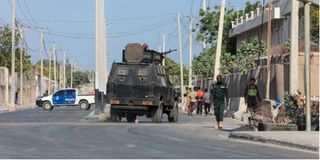Government steps up efforts to prevent Shabaab infiltration at borders

Security forces patrol outside a building which was attacked by suspected Al-Shabaab militants in Mogadishu on February 21.
Security agencies in the North Eastern region are now engaging local communities in tracking movement of Al -Shabaab militia from Somali to Kenya in efforts to curtail the rising cases of low scale attacks.
According to the Regional Commissioner Mr John Otieno, the teams are relying on the intelligence gathered from civilians and local leaders to further forestall illegal activities across the borders.
“Patriotic elders have undertaken to work with us to defeat terrorism. We understand that they have invaluable tip-offs and crucial information on how we beat the enemy,” the Commissioner said after chairing a meeting with local leaders and security teams in Wajir.
He added that more engagements have been lined up with elected leaders as well as clergy and peace committees to find long-term solutions to security challenges affecting the region.
At least three incidents have occurred this month, the latest being the Tuesday morning attack on a bus ferrying passengers from Nairobi to Mandera.
The “Ambasa” bus was sprayed with bullets by two unknown gunmen leaving three passengers nursing various gun wounds.
On June 7, a land rover ferrying police officers from Alungu to Elwak was hit by an Improvised Explosive Device (IED) that had been planted on the route.
On June 2, two police officers who were conducting patrols on the Elele-Takaba road a few kilometres from Alungu were killed and five others injured after they were hit by rocket propelled grenades by the militants.
Locals claimed the IED had been planted by al shabaab militants who had sneaked to the country from Somalia.
The radical Islamist group came under heavy crushing from the Somalia side following last year’s start of a countrywide operation that killed over 1,000 of its fighters.
On Tuesday, the Ministry of Interior confirmed that security and intelligence committees have been conducting reviews of the government’s responses to stop the insurgents from seeking refuge in Kenya.
Proximity to Somalia
“The county remains among those on the front line of the war against terror due to its geography and proximity to Somalia, which is progressively intensifying its community-led offensive against the insurgents,” a statement from the ministry said.
The government plans to open up the region to development with the commencement of the phased opening of the borders and the ongoing operation Maliza Uhalifu in the North Rift region that is meant to compliment security in the vast under-exploited Northern Kenya.
“North Eastern Kenya deserves equal access to national development as the other regions in the country, and the government has many projects and programmes in the pipeline for our people here. But without public safety and security, all these initiatives will fall through,” said the regional commander.
He added that the strategy seeks to leverage on synergy and invoke the spirit of patriotism to interrupt the deployment of recruits by terror networks and incapacitate their cross-border operations.
During his tour of the region in early February, Interior Cabinet Secretary Kithure Kindiki called upon the leaders and residents to step up their individual and collective responsibility in fighting Al-Shabaab adherents and urged them to share more information with the government.
“It’s not possible that Somalia can manage to flash out these criminal elements and we cannot. It’s not possible. I am here to ask our community and religious leaders to collaborate with us. You are the ones with the solution to the security issue in this region,” the CS said at the time.
Security teams have also heightened vigilance against cases of drugs-trafficking across the Kenya-Ethiopia border, with the spotlight fixed on some residual routes being exploited by the criminals.





